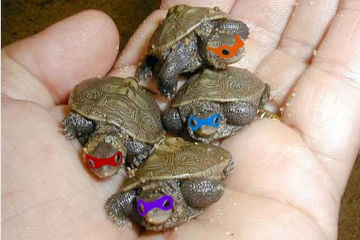What I’ve Learned:
“Wild type: tame on the outside, tamer on the inside.”
You would think the term “wild type” would describe the craziest, wackiest, furthest-out-there members of a species. Teen wolves. Mutant carny folk. Donald Trump.
But no.
In genetic terms, “wild type” refers to what you’d find “in the wild”, meaning the usual, most common, textbook examples. The ho-hummers. Been there, seen that.
When biologists describe things as wild type, they’re typically referring to one of two things: genotype or phenotype. The words look and sound nearly the same, but there’s an easy way to keep them straight:
Genotype starts the same way as “gene”, and indeed refers to DNA sequence, where genes live. A wild type genotype is one that matches the sequence most commonly found in the population. So what are you called if you have a different sequence, and your genotype varies from the norm? A mutant.
Not in a bad way, necessarily. But a mutation — either in one of your cells, or in one of your ancestors’ cells which was passed on to you — is how variation gets into genetic sequence, and those variations are tremendously important. Without mutations, we’d all have the same DNA. We’d all be susceptible to the same diseases. We’d have no flexibility as a species to survive. And we’d only have Teenage Ninja Turtles movies. Who the hell would watch those?
(Of course, according to Gattaca, we’d also all look like Jude Law and Uma Thurman. I’m sure there are downsides to that, somehow. I’ll let you know if I think of any.)
Then there’s phenotype, which starts with “phen”, so the easy way to remember that is “it’s not the ‘gene’ one”. Or make up something about “phenomenal”, maybe. Or “phenylalanine”. I don’t know. What am I, your mnemonics coach?
What phenotype refers to is outward appearance or traits. One or more DNA sequence changes (or genotypes) may lead to noticeable physical changes, or phenotypes. In fruit flies, for instance, there’s a gene that controls eye color. Certain genotypic changes, or mutations, in that gene lead to a phenotypic change: instead of beady little red eyes, the flies have beady little white ones.
Not as dramatic a physical change as you get from frappe-ing a fly’s DNA up with Seth Brundle’s, perhaps. But still, a distinctive phenotype — one for wild type, and one for mutants.
In the phenotypic sense, there is no single “wild type”. No one set of characteristics is standard, with offshoots of eye color and skin shade and curliness of hair radiating from it. You can compare variations to each other, but there’s no reference person or animal or bacterium to call ideal.
Likewise, you can come up with a “reference genome” for a species — and people have, for humans and fruit flies and rats and plants and plants and hundreds of other species. But each of these is just an average of the DNA that’s tested. One particular genotypic locus might have a certain sequence in fifty-one percent of the population, so it becomes “wild type”. But everyone else is then a “variant”, and none of us have the same set of millions of variants currently known. We’re all mutants, if you compare our DNA to the human reference genome, though we’re considered wild type in the majority of genomic positions.
Well, most of us are. Not counting Teen Wolf. Or carny folk. Or Trump. The only “wild type” of thing about them is their hair. Their scary mutant hair.



